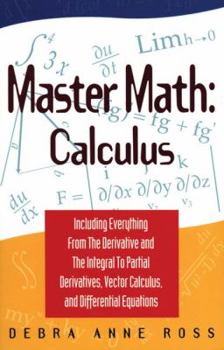Master Math: Calculus
Select Format
Select Condition 
Book Overview
Master Math: Calculus takes off right where the best-selling Master Math series left off, and provides everyone, even those who fear balancing their checkbooks, with new hope and answers to these and... This description may be from another edition of this product.
Format:Paperback
Language:English
ISBN:1564143376
ISBN13:9781564143372
Release Date:June 1998
Publisher:Cengage Learning
Length:352 Pages
Weight:0.90 lbs.
Dimensions:0.8" x 5.3" x 8.3"
Customer Reviews
1 rating
Master Math: Calculus Table of Contents
Published by Thriftbooks.com User , 24 years ago
Master Math: Calculus Table of ContentsIntroductionChapter 1. Functions1.1. Functions: types, properties and definitions 1.2. Exponents and logarithms 1.3. Trigonometric functions 1.4. Circular motion 1.5. Relationship between trigonometric and exponential functions 1.6. Hyperbolic functions 1.7. Polynomial functions 1.8. Functions of more than one variable and contour diagrams 1.9. Coordinate systems 1.10. Complex numbers 1.11. Parabolas, circles, ellipses and hyperbolasChapter 2. The Derivative2.1. The limit 2.2. Continuity 2.3. Differentiability 2.4. The definition of the derivative and rate of change 2.5. D (delta) notation and the definition of the derivative 2.6. Slope of a tangent line and the definition of the derivative 2.7. Velocity, distance, slope, area and the definition of the derivative 2.8. Evaluating derivatives of constants and linear functions 2.9. Evaluating derivatives using the derivative formula 2.10. The derivatives of a variable, a constant with a variable, a constant with a function and a variable raised to a power 2.11. Examples of differentiating using the derivative formula 2.12. Derivatives of powers of functions 2.13. Derivatives of ax, ex and ln x 2.14. Applications of exponential equation 2.15. Differentiating sums, differences and polynomials 2.16. Taking second derivatives 2.17. Derivatives of products: the product rule 2.18. Derivatives of quotients: the quotient rule 2.19. The chain rule for differentiating complicated functions9 2.20. Rate problem examples 2.21. Differentiating trigonometric functions 2.22. Inverse functions and inverse trigonometric functions and their derivatives8 2.23. Differentiating hyperbolic functions 2.24. Differentiating multivariable functions 2.25. Differentiation of implicit vs. explicit functions 2.26. Selected rules of differentiation 2.27. Minimum, maximum and the first and second derivatives 2.28. Notes on local linearity, approximating slope of curve and numerical methodsChapter 3. The Integral3.1. Introduction 3.2. Sums and sigma notation 3.3. The antiderivative or indefinite integral and the integral formula 3.4. The definite integral and the Fundamental Theorem of Calculus 3.5. Improper integrals 3.6. The integral and the area under a curve 3.7. Estimating integrals using sums and associated error 3.8. The integral and the average value 3.9. Area below the X-axis, even and odd functions and their integrals 3.10. Integrating a function and a constant, the sum of functions, a polynomial, and properties of integrals 3.11. Multiple integrals 3.12. Examples of common integrals 3.13. Integrals describing length 3.14. Integrals describing area 3.15. Integrals describing volume 3.16. Changing coordinates and variables 3.17. Applications of the integral 3.18. Evaluating integrals using integration by parts 3.19. Evaluating integrals using substitution 3.20. Evaluating integrals using partial fr




